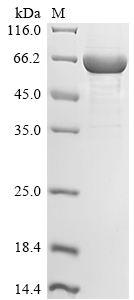The partial sequence of the human Schlafen family member 11 (SLFN11), covering amino acids 345-901, is linked with a 10xHis tag at the N-terminus to form the target gene. The target gene is amplified through PCR and cloned into expression vectors, creating recombinant plasmids. Transfection of recombinant plasmids into E. coli cells are followed by culturing for protein expression. The supernatant is collected and purified through affinity chromatography to obtain the recombinant human SLFN11 protein, which exceeds 85% purity as measured by SDS-PAGE.
The human SLFN11 is a nuclear protein that plays a critical role in the cellular response to DNA damage and stress, making it a significant factor in cancer biology and therapy resistance. Its expression is often associated with increased sensitivity to these agents, as it can enhance the effectiveness of treatments by promoting cell death in response to DNA damage [1][2][3]. Specifically, studies have shown that SLFN11 expression levels can serve as predictive markers for the response to cisplatin-based therapies in various cancers, including ovarian and colorectal cancers [2][4][5]. The methylation of SLFN11 has been identified as a mechanism that contributes to resistance against these therapies, as it leads to reduced expression of the protein [4][5].
In addition to its role in DNA damage response, SLFN11 has been implicated in regulating protein synthesis, particularly in the context of viral infections. It has been shown to inhibit the production of HIV-1 proteins by targeting host tRNAs, thereby limiting the replication of the virus [6][7]. This antiviral activity highlights SLFN11's potential as a therapeutic target in treating viral infections, as well as its broader implications in immune responses [6][7].
The functional mechanisms of SLFN11 involve its ability to bind to stressed replication forks, which are critical sites of DNA damage. This binding is independent of the ATR protein kinase-mediated checkpoint regulation, suggesting that SLFN11 can directly influence DNA repair processes [8]. Furthermore, SLFN11 has been shown to interact with various cellular pathways, including those involved in chromatin remodeling and transcriptional activation in response to replication stress [9].
References:
[1] Y. Peng, L. Wang, L. Wu, L. Zhang, G. Nie, & M. Guo, Methylation of slfn11 promotes gastric cancer growth and increases gastric cancer cell resistance to cisplatin, Journal of Cancer, vol. 10, no. 24, p. 6124-6134, 2019. https://doi.org/10.7150/jca.32511
[2] Y. Mu, J. Lou, M. Srivastava, B. Zhao, X. Feng, T. Liuet al., slfn 11 inhibits checkpoint maintenance and homologous recombination repair, Embo Reports, vol. 17, no. 1, p. 94-109, 2015. https://doi.org/10.15252/embr.201540964
[3] G. Zoppoli, M. Regairaz, E. Leo, W. Reinhold, S. Varma, A. Ballestreroet al., Putative dna/rna helicase schlafen-11 (slfn11) sensitizes cancer cells to dna-damaging agents, Proceedings of the National Academy of Sciences, vol. 109, no. 37, p. 15030-15035, 2012. https://doi.org/10.1073/pnas.1205943109
[4] T. He, M. Zhang, R. Zheng, S. Zheng, E. Linghu, J. Hermanet al., Methylation of slfn11 is a marker of poor prognosis and cisplatin resistance in colorectal cancer, Epigenomics, vol. 9, no. 6, p. 849-862, 2017. https://doi.org/10.2217/epi-2017-0019
[5] V. Nogales, W. Reinhold, S. Varma, A. Martínez-Cardús, C. Moutinho, S. Moránet al., Epigenetic inactivation of the putative dna/rna helicase slfn11 in human cancer confers resistance to platinum drugs, Oncotarget, vol. 7, no. 3, p. 3084-3097, 2015. https://doi.org/10.18632/oncotarget.6413
[6] P. Gupta, S. Peter, M. Jung, A. Lewin, G. Hemmrich-Stanisak, A. Frankeet al., Analysis of long non-coding rna and mrna expression in bovine macrophages brings up novel aspects of mycobacterium avium subspecies paratuberculosis infections, Scientific Reports, vol. 9, no. 1, 2019. https://doi.org/10.1038/s41598-018-38141-x
[7] A. Puck, R. Aigner, M. Modak, P. Cejka, D. Blaas, & J. Stöckl, Expression and regulation of schlafen (slfn) family members in primary human monocytes, monocyte-derived dendritic cells and t cells, Results in Immunology, vol. 5, p. 23-32, 2015. https://doi.org/10.1016/j.rinim.2015.10.001
[8] S. Hamada, S. Kano, J. Murai, T. Suzuki, N. Tsushima, T. Mizumachiet al., Schlafen family member 11 indicates favorable prognosis of patients with head and neck cancer following platinum-based chemoradiotherapy, Frontiers in Oncology, vol. 12, 2023. https://doi.org/10.3389/fonc.2022.978875
[9] J. Murai, H. Zhang, S. Tang, U. Jo, F. Moribe, Y. Maet al., Chromatin remodeling and immediate early gene activation by slfn11 in response to replication stress, Cell Reports, vol. 30, no. 12, p. 4137-4151.e6, 2020. https://doi.org/10.1016/j.celrep.2020.02.117






